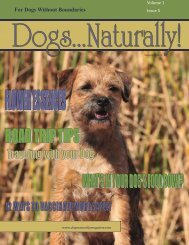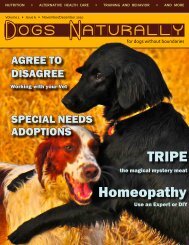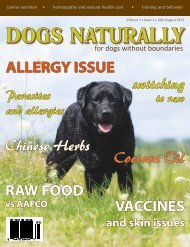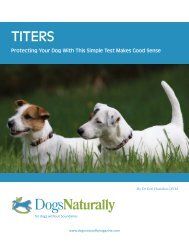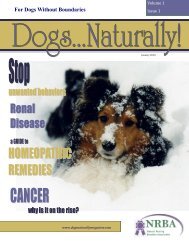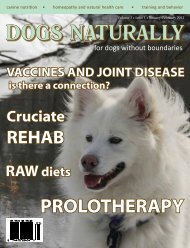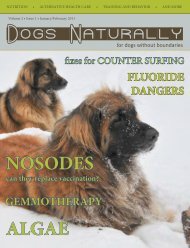Download the PDF Version - Dogs Naturally Magazine
Download the PDF Version - Dogs Naturally Magazine
Download the PDF Version - Dogs Naturally Magazine
You also want an ePaper? Increase the reach of your titles
YUMPU automatically turns print PDFs into web optimized ePapers that Google loves.
to specify which of <strong>the</strong>se it is, because cinnamon bark oil is<br />
a known dermal toxin and should never be used on <strong>the</strong> skin.<br />
Cinnamon leaf oil contains <strong>the</strong> chemical constituent eugenol,<br />
which can cause irritation to <strong>the</strong> mucus membranes; and you<br />
wouldn’t want your dog to lick this remedy off his skin or fur.<br />
While browsing my local health food store’s pet section, I noticed<br />
some all-natural flea collars. One of <strong>the</strong> ingredients listed<br />
was pennyroyal essential oil. I was shocked; one of <strong>the</strong> main<br />
chemical constituents in pennyroyal, pulegone, is known to<br />
cause abortions, and pennyroyal essential oil is also an oral<br />
toxin. I would never put this on my dog for <strong>the</strong>se two reasons.<br />
Two summers ago, we had an unusually large number of mosquitoes<br />
in Colorado. Our dogs were miserable and we were too,<br />
so I decided it was finally time to attempt to make a remedy.<br />
After much research and thought, I decided to put <strong>the</strong> following<br />
essential oils toge<strong>the</strong>r: geranium, lavender, lemongrass and<br />
lemon eucalyptus.<br />
I chose <strong>the</strong>se specific essential oils for <strong>the</strong> following reasons:<br />
Geranium (Pelargonium graveolens): The chemical constituent<br />
citronellol helps makes this essential oil an insecticide. It also<br />
helps with skin issues such as skin congestion and dermatitis.<br />
Lavender (Lavendula angustifolia): One of its chemical constituents<br />
is cineol, which may be why it is considered an insecticide.<br />
Lavender is also very soothing to <strong>the</strong> skin so if <strong>the</strong>re were any<br />
skin flare-ups, this essential oil would help.<br />
Lemongrass (Cymbopogon citratus): Lemongrass has a high<br />
concentration of <strong>the</strong> chemical constituent citral and contains<br />
<strong>the</strong> chemical constituent citronellol which makes this essential<br />
oil a very nice insecticide.<br />
Lemon Eucalyptus (Eucalyptus citriodora): Its main insecticidal<br />
chemical components are citronellal (70-75%) and citronellol.<br />
There are a few species of eucalyptus oils that are considered<br />
toxic, although if taken orally <strong>the</strong> dose would have to be 3.5<br />
ml or more. According to Robert Tisserand’s book, Essential Oil<br />
Safety, he considers Eucalyptus citriodora to be non toxic.<br />
When I am creating a product for my dogs, I want it first to be<br />
very safe. The proportions of <strong>the</strong> essential oils are low and diluted<br />
in a spray bottle containing eight ounces of water. If an<br />
animal starts to show any adverse reaction to <strong>the</strong> ingredients,<br />
I stop using <strong>the</strong> product immediately. Some dogs dislike <strong>the</strong><br />
smell of <strong>the</strong>se essential oils and that is a valid indication to stop<br />
using <strong>the</strong>m.<br />
After receiving more phone calls from clients about an all-natural<br />
dog fly spray, I decided to make a product from <strong>the</strong> oils listed<br />
above. I’ve found it to be effective, but its effects are not longlasting<br />
and it does need to be reapplied throughout <strong>the</strong> day.<br />
With so many products and home remedies to choose from,<br />
you need to read <strong>the</strong> ingredients carefully and <strong>the</strong>n research<br />
<strong>the</strong> ingredients before applying <strong>the</strong>m to your dog, whe<strong>the</strong>r it<br />
is an all-natural product or a chemical-based product from a<br />
pharmaceutical company. Unfortunately, pet products are not<br />
consistently regulated, so we can’t assume that all remedies on<br />
<strong>the</strong> market are safe for our pets.<br />
While all-natural remedies can be helpful, <strong>the</strong>y are not 100% effective.<br />
You may wish to take some o<strong>the</strong>r preventive measures<br />
to combat <strong>the</strong>se pests. Have a flea and tick comb on hand for<br />
your dog and use it after a walk or after he has been playing outside.<br />
Keep all <strong>the</strong> dog beds and your bedding clean, and keep<br />
your floors and carpeting clean during <strong>the</strong> infestation season.<br />
Our dogs are very sensitive beings, so be safe and think about<br />
what remedies you choose! f<br />
Frances Fitzgerald Cleveland’s ground breaking Animal Aroma<strong>the</strong>rapy<br />
work at The Denver Zoo with Orangutans, Gorillas<br />
and Black Crested Macaques was covered in <strong>the</strong> Denver Post<br />
and L.A.Times. Frances lives in Colorado where she teaches and<br />
practices <strong>the</strong> art of working with essential oils and plants and<br />
manufactures her internationally sold products.<br />
<strong>Dogs</strong> <strong>Naturally</strong> <strong>Magazine</strong> | May/June2012<br />
21



